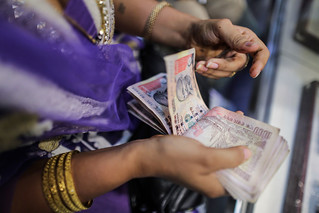
PREV ARTICLE
NEXT ARTICLE
FULL ISSUE
PREV FULL ISSUE
INDIA'S BIG STEP BACK FROM CASHPablo Hoffman forwarded this New Yorker article by Nathan Heller (published November 29, 2016) about the currency upheaval playing out in India, and the notion of
discontinuing large bills to combat crime. -Editor
The decree is striking especially because Indian life is cash-intensive (even massive transactions, such as real-estate purchases, are routinely conducted in paper currency) and because the banned bills are in widespread daily use. A thousand rupees is about fifteen U.S. dollars; holders of the discontinued bills, Modi decreed, must trade in their obsolete notes within fifty days, after which time they will be worthless. In his recent book, “The Curse of Cash,” Rogoff laid out a plan by which the U.S. could phase out its (commercially rare) large bills over nearly a decade. The discontinued rupee bills, by contrast, will be worthless by the New Year. The move is the equivalent of an ocean liner turning with the radius of a Porsche. Although India undertook similar demonetization projects in 1946 and 1978, Modi’s program is recently unmatched in scale and speed. It fits, however, with one of his big endeavors as Prime Minister. As I mentioned in my magazine piece, Modi has been on an intensifying crusade against banknotes, in an effort to stem widespread tax evasion and corruption. (India loses more than three hundred billion dollars in tax evasion every year.) Even by that standard, though, his new, fast-acting plan is radical. I phoned Rogoff to see what he made of India’s new big-bill ban. “It’s a big show of force,” he told me. Strictly speaking, the Indian demonetization is less about phasing out cash than it is about accounting for underground money. (With big bills about to be worthless, citizens will have to produce their secret stashes for exchange; those showing up with unaccounted-for millions are apt to raise red flags.) Instead of driving the cash economy into small bills, as Rogoff advises, Modi has introduced a bigger bill, a new two-thousand-rupee note, which Indians can get when they bring in their discontinued bills. In Rogoff’s view, though, Modi’s actions will have the long-term effect of reining in the cash economy by making Indians wary of paper money. “When you take bills out of circulation at short notice, that’s going to cut cash demand in the future,” Rogoff told me. “He’s aiming, really, at the psychology.” To read the complete article, see: To read the earlier E-Sylum article, see:  Wayne Homren, Editor The Numismatic Bibliomania Society is a non-profit organization promoting numismatic literature. See our web site at coinbooks.org. To submit items for publication in The E-Sylum, write to the Editor at this address: whomren@gmail.com To subscribe go to: https://my.binhost.com/lists/listinfo/esylum All Rights Reserved. NBS Home Page Contact the NBS webmaster 
|
